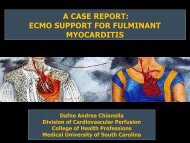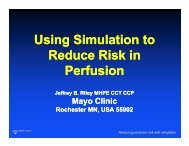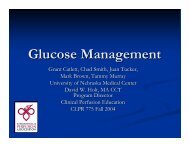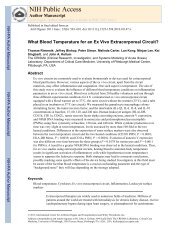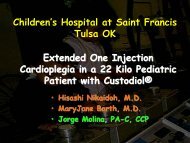PowerPoint Presentation (PDF) - Perfusion.com
PowerPoint Presentation (PDF) - Perfusion.com
PowerPoint Presentation (PDF) - Perfusion.com
You also want an ePaper? Increase the reach of your titles
YUMPU automatically turns print PDFs into web optimized ePapers that Google loves.
PHILADELPHIA, PENNSYLVANIA
Acute Massive Pulmonary Embolism (AMPE)<br />
The Aria Health Experience:-<br />
Rapid Response and Two Surgical Techniques which resulted in<br />
100% positive out<strong>com</strong>e in the cardiac operating room.<br />
H.MOHAMED, CCP., J.SCHULTZ, CCP., T.ZOMBOLAS, CCP., R. METCALF, MD.
Recent National Incidents:<br />
February 2011:<br />
Transgender hip-hop singer from Philadelphia sought for the<br />
death of a young British female entertainer.<br />
March 2011:<br />
Tennis star Serena Williams, on a flight from NY to LA,<br />
suffered from a PE.
OBJECTIVE / PURPOSE:AMPE<br />
- Raise an awareness with causes and <strong>com</strong>plications<br />
- Review the multidisciplinary team approach to treatment:<br />
- <strong>Perfusion</strong>ist, Surgeon, Anesthesiologist, Intensivist,<br />
Radiologist<br />
- Stat admission to the Cardiac OR<br />
- Assessment of RV Function / Strain<br />
- Assessment of Lung Function<br />
- Review / Discuss our experience and treatment<br />
- Highlight a possible new treatment approach with new equipment
HISTORY<br />
1872 - Dr. Trendelenburg studied 9 hospitalized patients with PE. He<br />
performed 2 pulmonary embolectomies and both patients died within<br />
37 hours.<br />
1924 - Dr. Kirschner, a student of Trendelenburg, performed the first<br />
successful pulmonary embolectomy. This case was presented at the<br />
Berlin Surgical Conference. Dr. Oschner from the USA attended this<br />
conference and took note of the procedure.<br />
1932 - Drs. Oschner and Debakey advocated IVC ligation to prevent<br />
pulmonary embolus.<br />
1932 - While a surgical resident, Dr. Gibbon witnessed an<br />
unsuccessful open attempt to save the life of a young woman who had<br />
sustained a pulmonary embolus - this was the catalyst for the<br />
development of the Heart / Lung Machine.<br />
1934 - Dr. Homans performed the first prophylactic venous ligation.
HISTORY cont’d.<br />
1961 - Dr. Cooley attempted a pulmonary embolectomy<br />
using CPB.<br />
1962 - Dr. Sharp performed the first successful pulmonary<br />
embolectomy in the United States.<br />
Two surgical approaches ultimately evolved for the<br />
management of pulmonary embolus.<br />
1. Operations that focused on the removal of an embolus<br />
to the lung.<br />
2. Operations that were designed to prevent embolization.<br />
Note: Sudden interruption of vena cava flow caused a<br />
decreased cardiac output and severe peripheral edema
Background Information<br />
-“Pulmonary embolism is a life-threatening condition that occurs<br />
when a thrombus or other material blocks the pulmonary arterial<br />
system in your lungs”.<br />
-This is an extremely <strong>com</strong>mon and highly lethal condition that is a<br />
leading cause of death in all age groups.<br />
-One of the most prevalent disease processes responsible for<br />
in-patient mortality (30-50%)<br />
-Overlooked diagnosis.
Why is this clinical picture of PE so important?<br />
Prompt diagnosis and treatment can dramatically reduce the<br />
mortality and morbidity rate.<br />
Majority of the cases are unrecognised clinically.<br />
One third of the patients who survive an initial PE die of a future<br />
embolic episode.<br />
Many patients who die of PE have not had any diagnostic workup<br />
nor have they received any prophylaxis for the disease.<br />
In most cases, the CLINICIANS have not even considered the<br />
diagnosis of PE.
Pathophysiology<br />
PE is not a disease in and of itself.<br />
It is often a fatal <strong>com</strong>plication of underlying venous<br />
thrombosis.<br />
Normally microthrombi (RBC,Platelets and Fibrin) are formed<br />
and lysed within the venous circulatory system.<br />
Under pathological conditions, these microthrombi may<br />
escape, propagate and will block the pulmonary blood vessels<br />
causing PE.
Facts about PE.<br />
3 rd most <strong>com</strong>mon cause of death.<br />
2 nd most <strong>com</strong>mon cause of unexpected death in most age<br />
groups.<br />
60% of patients dying in the hospital have had a PE.<br />
Diagnosis has been missed in about 70% of the cases
National Statistics<br />
There are approximately 650,000 occurrences in the United States.<br />
400,000 of these patients go undiagnosed.<br />
The Center for Disease Control (CDC) estimated that about 250,000<br />
Americans annually suffer from a PE.<br />
About 100,000 deaths occur annually and these could have been<br />
prevented with proper diagnosis and treatment.
National Statistics cont’d.<br />
This type of obstruction can manifest itself into a myriad of<br />
physiologic events which can ultimately result in cardiac arrest and<br />
death of up to 70-90% of these patients in the first hour.<br />
Approximately 75% of autopsy-proven Pulmonary Embolisms (PE)<br />
are not detected clinically.
National Statistics cont’d.<br />
African Americans are the highest risk group with a 50%<br />
higher incidence than American Whites.<br />
Asian/Pacific Islanders/American Indian patients have a<br />
markedly lower risk.<br />
The risk factor is increased in pregnancy and during the<br />
postpartum period.<br />
The mortality rate remains 20-30% higher in men than in<br />
women.
RECOMMENDATIONS<br />
CPB for pulmonary embolism should be utilized for those<br />
patients who are hypotensive (systolic pressure
Definition<br />
A pulmonary embolus is described as a blockage of the:<br />
- Main Pulmonary Artery (PA).<br />
- The Right and/or Left Pulmonary Arteries.<br />
- The Segmental Pulmonary Arteries.<br />
…by either a blood clot (thrombus), fat, gas (nitrogen, air, CO 2),<br />
tumor cells, amniotic fluid, septic embolism, talc or elemental<br />
mercury and more recently silicone.
Silicone Embolus<br />
Former Miss. Argentina (1994) died in December 2009 from<br />
silicone <strong>com</strong>plications of a “gluteal plasty” which involved<br />
injection of liquid silicone.<br />
In November 2006, this occurrence (44 patients) was presented at<br />
the annual meeting of the Radiological Society of North America<br />
(RSNA) where the idea of “Pump Up” parties was discussed for the<br />
very first time.<br />
Often members of the male-to-female transgender <strong>com</strong>munity<br />
gather for liquid silicone injections in hopes of feminizing their<br />
appearance.
Definition cont’d.<br />
Medically, AMPE is defined as an occlusion of the PA that exceeds<br />
50% of its cross sectional area, resulting in progressive<br />
hemodynamic <strong>com</strong>promise.<br />
Massive PE is also defined as the presence of persistent systemic<br />
hypotension or cardiogenic shock and signs of right ventricular<br />
dysfunction (RVD).<br />
A sub-massive PE is defined as moderate to large clot, presence of<br />
RVD, and normal arterial blood pressure.
SIGNS AND SYMPTOMS:<br />
Signs and symptoms of PE may include any or all of the<br />
following:<br />
∙chest pain at rest ∙anxiety<br />
∙S.O.B. at rest ∙dizziness<br />
∙hyperventilation ∙diaphoresis<br />
∙syncope ( B/P, CO, PAP) ∙tachycardia (>100 b/p/m) ∙clammy<br />
skin ∙hemoptysis (13%)<br />
∙swollen/painful legs ∙wheezing/crackles<br />
∙apnea ∙peripheral cyanosis<br />
∙dyspnea (73%) ∙painful respirations<br />
∙cough (37%) ∙fever<br />
∙pleuritic chest pain (66%) ∙T wave inversions (leads V1-4)
TESTS USED TO CONFIRM PE:<br />
∙Quantitative D-dimer assay test* ∙Ventilation/perfusion Scan ( V/Q) ∙Pulse Oximetry ∙CT Angiography<br />
∙Pulmonary Arteriogram ∙CT Scan (helical)<br />
∙Doppler Ultrasonography ∙Hemodynamics<br />
∙Venogram of the leg ∙Arteriogram of the leg<br />
∙Arterial Blood Gas (ABG) ∙EKG (S-T in V1- 4)<br />
∙Physical exam/family history or prior Deep Vein Thrombosis (DVT)/PE<br />
∙Echocardiography<br />
<br />
*D-dimer ASSAY TEST:<br />
The Quantitative D-dimer assay test is also referred to as the “Fibrin<br />
Degradation test” or “Fragment D-dimer”. The Fragment D-dimer assesses both<br />
thrombin and plasmin activity. Related tests may include; Fibrin Split Products<br />
(FSP), Fibrin Degradation Products (FDP), Prothrombin Time (PT), Partial<br />
Thromboplastin Time (PTT); Fibrinogen, and or Platelet count.
TREATMENT OF PE:<br />
First Line Treatment: NON-ACUTE SITUATION<br />
∙O 2 Therapy<br />
∙Intubation/Ventilation<br />
∙Insertion of Vena Caval Filter<br />
Bird’s nest filter (Infrarenal)<br />
Greenfield filter (Suprarenal)<br />
∙Sildenafil (Viagra)<br />
∙Anticoagulant/Thrombolysis<br />
-Heparin<br />
-Coumadin<br />
-Tissue Plasminogen Activators (TPA)<br />
∙Low Molecular Weight Heparin
TREATMENT OF PE: cont’d<br />
Second Line Treatment: ACUTE SITUATION<br />
∙Surgical removal with the use of CPB<br />
∙*Surgical removal with the Vortex Angiovac cannula<br />
(new technique)<br />
∙Intubation / Ventilation<br />
∙O 2 Therapy<br />
∙Insertion of Vena Caval Filter<br />
Bird’s nest filter (Infrarenal)<br />
Greenfield filter (Suprarenal)<br />
∙Anticoagulant/Thrombolysis<br />
-Heparin<br />
-Coumadin<br />
-TPA<br />
-Low Molecular Weight Heparin
AngioVac System<br />
Right Femoral 22 fr.to Left Femoral 18 fr. venous bypass.<br />
Utilizing a centrifugal pump and no oxygenator in line.<br />
Tracking over an Amplatz stiff wire, the AngioVac cannula is<br />
positioned first in the main PA. The balloon actuated funnel tip on<br />
the AngioVac is then opened and the pump flow is initiated and<br />
then optimized.
Vortex Medical Inc.<br />
AngioVac System
∙Sudden Cardiac death<br />
COMPLICATIONS OF PE:<br />
∙Long term anticoagulant prophylaxis potentially leading to<br />
bleeding problems<br />
∙Right Ventricular Hypertophy (RVH) / Cor Pulmonale<br />
∙Respiratory Failure<br />
∙Cardiogenic shock ( C.O., B/P)<br />
∙Palpitations
Regular exercise<br />
Anticoagulant prophylaxis<br />
Hydration<br />
Alcohol intake (decrease)<br />
Use of <strong>com</strong>pression stockings<br />
PREVENTION OF PE:<br />
Mobilization when taking long travel trips<br />
Use professionals for cosmetic surgeries
Chest X-Ray of PE
Pulmonary Angiogram
Pulmonary Angiogram X-Ray
Contrast CT showing Pulmonary Embolus
The Aria Experience<br />
Methods: Two Cardiopulmonary Bypass Techniques<br />
- Deep Hypothermic Circulatory Arrest (DHCA)<br />
with Cold Retrograde Cerebral <strong>Perfusion</strong> (RCP)<br />
(n=7)<br />
- Normothermic (Tepid)<br />
(n=13)
DHCA Technique (Group A)<br />
Cannulation: Aortic & Bi-Caval Venous Cannulation<br />
Cardioplegia administration: Antegrade/Retrograde (warm/cold)<br />
Systemic cooling: As per protocol to 18 o C<br />
Circulatory Arrest: Initiation<br />
Initiation of RCP: Flow & pressure as per protocol<br />
Surgical removal of PE<br />
Cessation of RCP<br />
Rewarm as per protocol<br />
Administration of warm retrograde blood only to the heart<br />
TEE Assessment<br />
Termination of CPB (See table 1-Group A)
Population<br />
Group A (Circ. Arrest)<br />
7<br />
Average Age Male = 48.8 /Female = 33<br />
Sex Male = 6 Female = 1<br />
Mean Arterial Pressure 80 (mmHg)<br />
Mean PA Pressure n /a* (mmHg)<br />
Mean CVP (20-30 mmHg) (SVC)<br />
Average Retrograde<br />
Cerebral Blood flow<br />
260 mL/min (180-350)<br />
Mean SvO2 (CPB) 82<br />
Mean Pre Bypass rSO2<br />
52<br />
Mean Cooling rSO2<br />
77<br />
Mean RCP rSO2<br />
85<br />
Mean Warming rSO2<br />
73<br />
Cannulation Same<br />
(AO/IVC/SVC)<br />
Average Pump Time 135 Min.<br />
Average Crossclamp 41Min.<br />
Time<br />
Average Circ Arrest 41 Min. (30-66)<br />
Time<br />
Lowest temperature<br />
13<br />
during Circ. Arrest<br />
o C<br />
Average Cooling Time 52 Min.<br />
Average Rewarming 77 Min.<br />
Time<br />
* = No PA line was inserted into the Pulmonary Artery pre-CPB.
Normothermic (Tepid) Technique<br />
Cannulation: Aortic & Bi-Caval venous cannulation (Mitral valve)<br />
Cardioplegia administration: Antegrade/Retrograde (warm/cold)<br />
15 minutes intervals<br />
Systemic temperature: Drift to no less than 34 o C<br />
Surgical removal of PE<br />
Rewarm to 37 o C<br />
Administration of warm retrograde blood only to the heart<br />
TEE Assessment<br />
Termination of CPB (See table 1-Group B)
Group B (Normothermic)<br />
-Drift to 34 o Population<br />
C<br />
13<br />
Average Age Male = 54.2 /Female = 49.3<br />
Sex Male = 5 Female = 8<br />
Mean Arterial Pressure 95 (mmHg)<br />
Mean PA Pressure n /a* (mmHg)<br />
Mean CVP ?<br />
Average Retrograde<br />
Cerebral Blood flow<br />
0<br />
Mean SvO2 (CPB) 72<br />
Mean Pre Bypass rSO2<br />
52<br />
Mean Cooling rSO2<br />
NA<br />
Mean RCP rSO2<br />
NA<br />
Mean Warming rSO2<br />
68<br />
Cannulation Same<br />
Average Pump Time 64 Min.<br />
Average Crossclamp Time 45 Min.<br />
Lowest temperature<br />
during CPB<br />
34 o C<br />
Average Cooling Time 0<br />
Average Rewarming Time 15<br />
* = No PA line was inserted into the Pulmonary Artery pre-CPB.
Group A (Circ. Arrest) Group B (Normothermic)<br />
-Drift to 34 o C<br />
Population 7 13<br />
Average Age Male = 48.8 /Female = 33 Male = 54.2 /Female = 49.3<br />
Sex Male = 6 Female = 1 Male = 5 Female = 8<br />
Mean Arterial Pressure 80 (mmHg) 95 (mmHg)<br />
Mean PA Pressure n /a* (mmHg) n /a* (mmHg)<br />
Mean CVP (20-30 mmHg) (SVC) ?<br />
Average Retrograde 260 mL/min (180-350)<br />
0<br />
Cerebral Blood flow<br />
Mean SvO2 (CPB) 82 72<br />
Mean Pre Bypass rSO2 52 52<br />
Mean Cooling rSO2 77 NA<br />
Mean RCP rSO2 85 NA<br />
Mean Warming rSO2 73 68<br />
Cannulation Same<br />
Same<br />
(AO/IVC/SVC)<br />
Average Pump Time 135 Min. 64 Min.<br />
Average Crossclamp Time 41Min. 45 Min.<br />
Average Circ Arrest Time 41 Min. (30-66) 0<br />
Lowest temperature<br />
13 o C 34 o C<br />
during CPB<br />
Average Cooling Time 52 Min. 0<br />
Average Rewarming Time 77 Min. 15<br />
* = No PA line was inserted into the Pulmonary Artery pre-CPB.
BLOOD GASES<br />
Pre Intubation pH CO 2 O 2<br />
Normothermic 7.436 (7.37-7.52) 35 (27-56) 70.2 (56-86)<br />
Circ. Arrest 7.325 (7.25-7.40) 41 (27-55) 75.5 (58-93)**<br />
On CPB pH CO 2 O 2<br />
Normothermic 7.352 (7.27-7.41) 40.9 (31-53) 328.7 (173-488)<br />
Circ. Arrest 7.281 (7.10-7.47) 52.4 (40-70) 539 (408-696)<br />
Post Bypass pH CO 2 O 2<br />
Normothermic 7.376 (7.30-7.47) 40.5 (29-48) 305.2 (105-487)<br />
Circ. Arrest 7.314 (7.25-7.37) 44.1 (36-59) 126 (64-218)***<br />
** = Demonstrating gas exchange problems<br />
*** = Still denoting gas exchange problems
Summary<br />
The Keys to Our Management Strategy<br />
- Mandatory multidisciplinary approach.<br />
- 24/7 availability.<br />
- Rapid and a precise diagnosis with an immediate transfer to the<br />
CTOR (resembling Rescue Therapy) (LIKE VAD/ECMO)<br />
- Execution of a precise care plan by - <strong>Perfusion</strong>ist<br />
- Surgeon<br />
- Intensivist<br />
- Radiologist<br />
- Anesthesiologist<br />
- ICU staff<br />
- Results - 100% survival rate in the CTOR
Summary cont’d<br />
In a nonrandomized <strong>com</strong>parison of surgical and medical treatment<br />
in hemodynamically <strong>com</strong>promised patients with massive PE, the<br />
medical group had an increased mortality rate, increased number<br />
of hemorrhagic events and a higher incidence of recurrent PE.<br />
Gulba DC, Schmid C, Borst HG, Lichtlen P, Dietz R, Luft FC. Medical <strong>com</strong>pared with Surgical Treatment for<br />
Massive Pulmonary Embolism. Lancet. 1994:343:576-577.<br />
Currently our practice uses only the “tepid” CPB approach when<br />
we treat Acute Massive Pulmonary Embolism.
Thank You<br />
Questions????



